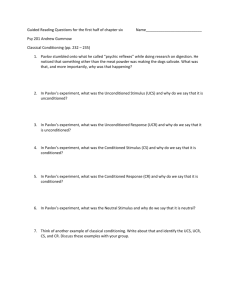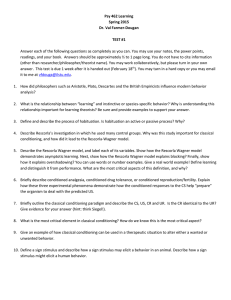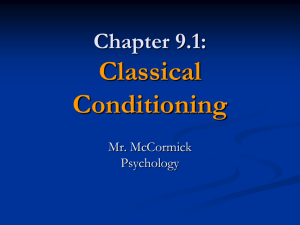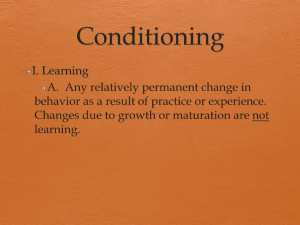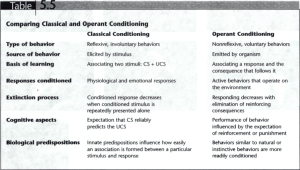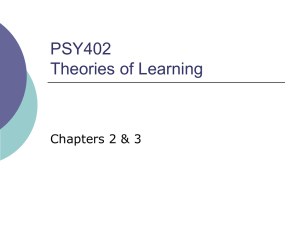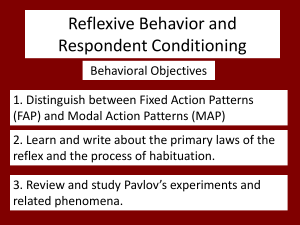Pavlovian or Classical Conditioning
advertisement
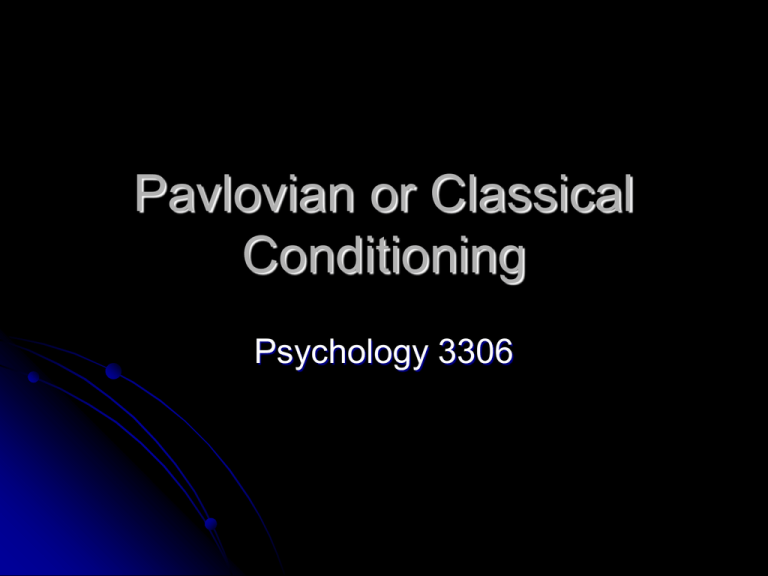
Pavlovian or Classical Conditioning Psychology 3306 Introduction Pavlov was working on digestion, the rest is history! Figured that lots of dogs’ behaviour may have involved this conditional redirection of reflexes Called the phenomenon ‘Conditional Reflexes’ Conditional? Yes conditional Was mistranslated and ‘conditioned’!!! So that is where we get the term conditioning from Key terms Unconditioned Stimulus (UCS or US) Biologically relevant stimulus, that without prior learning elicits an…. Unconditioned Response (UR or UCR) Conditioned Stimulus (CS) Neutral stimulus that with many CS – US pairing elicits a Conditioned Response (CR) Cool conditioning stuff Seems that pretty much any reflex can be hooked up Today we concentrate on a few different preparations Human eyeblink (rabbits too) CER (Conditioned emotional response) or suppression SCR (Skin conductivity response) Taste aversion or food aversion Early theoretical ideas Pavlov and stimulus substitution US replaced by CS However the CR is not always the same as the UR Sign tracking takes this idea into account actually Weak, but intuitively pleasing Perhaps physiology? Pavlov thought there were CS and US centres in the brain Hmmm, don’t seem to be, though some responses are hooked up to specific brain regions What is the connection though is it S – S or S – R? S-S and S-R US CS UR If we could just get rid of that US – UR bond….. US CS UR Rescrola (1973) So, how do you get rid of a response that is hard wired to a stimulus? Well, if you use CER, then your response is startle right? How do you get rid of a startle reflex? Habituation!! (Bob is a smart man) Design Group Phase 1 Phase 2 Test Habituation L -> N Noise Light Control Nothing Light L -> N Results Less suppression in Habituation group (In other words, more responding) Therefore, the connection MUST be S – S WOW! Some important properties of Pavlovian conditioning Acquisition Asymptote Extinction Spontaneous recovery Disinhibition Rapid Reacquisition Conditioned Inhibition Summation Test B+ A AB Retardation Test A AB Generalization So you will get a response (CR) to a given CS. Just like with habituation, you will get generalization Just like with habituation the less similar the new CS is to the original, the less CR you get Discrimination Sort of the opposite of Generalization CS+ and CS Animal responds (CR) to S+ not to S Discrimination gets too hard you get ‘neuroses’ Temporal Relationships Simultaneous conditioning Short delay Long delay Trace conditioning Backwards Again, contiguity alone does not do the trick, no surprise here Correlation of events CS- CSCSCSold control group, animal learns what? CS + CSCS+ Rescorla Control CS- CS+ CS+ CS+ CS+ CS+ CS+ CS- Conditional probability The animal basically compares p(US | CS) with p(US | no CS) The greater the difference the greater the conditioning Long term more than short term Whole new take on learning Other paradigms Higher order conditioning Sensory preconditioning Outside the lab too! Daily life Systematic desensitization Aversive counterconditioning Flooding

